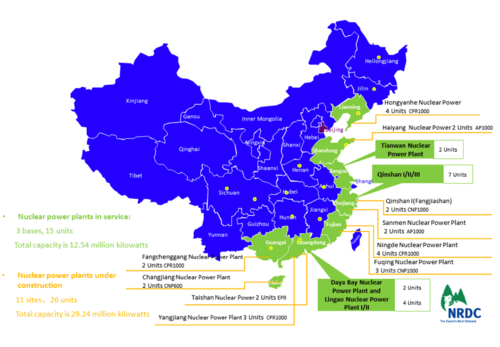In China and other developing countries, increasing electricity demand and concern about pollution from coal-fired power and its impact on climate change have led policymakers to focus on expanding nuclear power as a source of electricity. Before the March 2011 Fukushima nuclear disaster, China had been undertaking the world’s largest nuclear power plant construction program, with plans to expand its then approximately 11.5 GW of nuclear power to as much as 80 GW of nuclear capacity by 2020. (Given that current reactors are about 1 GW in size, this would be equivalent to building nearly 70 reactors over a decade.) In expanding at this pace, China was projected to meet its 2007 “Nuclear Power Medium- and Long-Term Development Plan (2005-2020)” target to have 40 GW of nuclear power capacity in operation by 2020 a full five years early, by 2015.
 Map of nuclear power plants in operation and under construction
Map of nuclear power plants in operation and under construction
Following Fukushima, however, Beijing immediately suspended approval of all new nuclear power projects while it undertook a comprehensive safety review of existing and under-construction nuclear power plants, as well as research reactors and fuel cycle facilities, and developed its Twelfth Five Year Plan for Nuclear Safety. In June 2012, after gaining approval of the State Council in principle, the National Nuclear Safety Administration released drafts of the Nuclear Safety Plan (Chinese here) and the "Report on Safety Inspection of National Civilian Nuclear Facilities" (Chinese here) for public comment.
As discussed in the Safety Inspection report, the safety inspection took over 9 months and covered 11 areas of safety, including site selection and external event evaluation; flood and earthquake resistance capacity; extreme natural disaster prevention and protection; electricity blackouts and emergency plans; severe accident prevention and mitigation; environmental monitoring systems; and emergency response system effectiveness.
The report concluded that operating reactors "basically fulfill" China's nuclear safety laws and regulations and the International Atomic Energy Agency's most recent standards, that they have the capacity to respond to design-basis accidents and severe accidents, and that safety risks are under control. However, in spite of these conclusions, the inspection report and nuclear safety plan also identified areas for improvement. In particular, the nuclear safety plan lays out short- (by the end of 2012), mid- (by the end of 2013) and long-term (by 2015) tasks to strengthen safety for operating and under-construction plants, research reactors and fuel cycle facilities.
For example, short-term tasks for operating reactors included inspecting and waterproofing all openings, electric cable lines, etc.; ensuring cooling functions for the reactor core and spent fuel in the event of a blackout, through mobile generators and pumps; and ensuring the effectiveness of seismic monitors and strengthening capacity to respond to earthquakes. Medium-term tasks include strengthening flood response measures; re-evaluating earthquake and tsunami risks for coastal plants and undertaking necessary changes; establishing and implementing severe accident management guidelines; evaluating and implementing improvements to respond to severe accidents and hydrogen explosions; and establishing response plans for multi-reactor emergencies. The long-term task for operating reactors is to undertake probabilistic safety assessments for external accidents. It is vital that these short, medium and long-term tasks are implemented and that the steps taken to improve safety are reported to the public. (See the excellent analysis of the inspection report and safety plan by Zhou Yun of Harvard's Belfer Center.)
In addition to the measures to improve the safety of nuclear power plant facilities, the nuclear safety plan also discusses changes needed to improve the regulation of nuclear power safety in China. NRDC has been advocating for changes to strengthen the regulatory capacity and role of China's National Nuclear Safety Administration, having held a workshop in June 2011 on strengthening nuclear safety post-Fukushima and publishing recommendations in various Chinese media outlets for strengthening China's regulatory system. We were thus pleased to see that a number of the changes called for in the nuclear safety plan echo our recommendations for strengthening China's nuclear safety regulatory system, including that China:
1. Rationalize the duties and functions of nuclear safety management among the various agencies responsible for nuclear power in China;
2. Strengthen the independence, authority, and professionalism of the nuclear safety regulatory body;
3. Strengthen the capacity and expertise of the nuclear safety regulatory body;
4. Ensure appropriate checks and balances on the power of the nuclear safety regulatory body;
5. Strengthen the establishment of nuclear safety culture, increase transparency of nuclear and radiation safety information, and establish mechanisms for public participation;
6. Strengthen nuclear safety laws and regulations and pass the “Atomic Energy Law” as soon as possible;
7. Establish a nuclear safety fund to provide adequate compensation in the event of an accident;
8. Strengthen the nuclear safety regulatory body’s international cooperation by establishing the nuclear safety regulatory body as a primary representative to the IAEA;
9. Ensure that the nuclear safety regulatory body participates in every level of nuclear accident emergency planning and provides technical support to local governments on nuclear accident emergency response.
In October, the State Council approved the nuclear safety plan with some slight revisions (see the revised version in Chinese here and an article in Chinese about the changes here). Later that month, the State Council Standing Committee also approved the Nuclear Power Safety Plan (2011-20) and the Nuclear Power Mid- and Long-Term Development Plan (2011-20) (see announcement in Chinese; neither of these plans has yet been made available online). In approving these plans, China officially lifted the freeze on approving new nuclear power plants, while also deciding not to build any inland nuclear power plants through 2015 and, significantly, to require all new plants to meet higher Generation III safety standards (see English news articles here and here). Although China has not announced new nuclear power installed capacity targets for 2020, it is expected that targets will be adjusted downward from previous expectations. We applaud China's decision to take a more cautious approach to development and hope this reflects a strengthened emphasis on nuclear safety as the primary consideration in developing its nuclear power program.
There is still more that China can do to improve the quality of its nuclear safety regulation. A significant and common sense step would be to take its nuclear safety regulatory body out of its current position in the Ministry of Environmental Protection and to set up a new, independent regulatory body directly under the State Council or National People's Congress, as would fit China's political system. The establishment of a National Nuclear Safety Regulatory Commission that is an independent legal entity with its own budget, human resources and decision-making authority would help to ensure that China's regulators have the tools necessary to effectively regulate the safety of China's rapidly expanding nuclear power program. China must also quickly pass the Atomic Energy Law and a Nuclear Safety Law to provide a comprehensive legal foundation for China's nuclear development and safety.
Nuclear power could be important in helping China to diversify its electricity mix, but only if it cautiously developed in a manner that places safety first in every aspect of development, operation and regulation. The occurrence of one major accident would bring irreparable harm to the lives and property of Chinese citizens and the environment. It would also bring unprecedented doubt and damage to China's nuclear industry and with it the prospects for future development of China's nuclear power program.
(This post was co-written with my colleagues Jingjing Li, Jason Portner and Christine Xu. )


